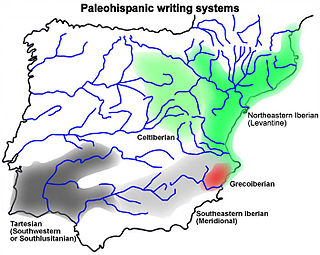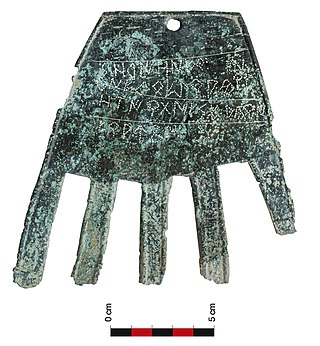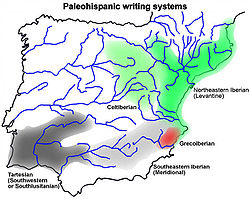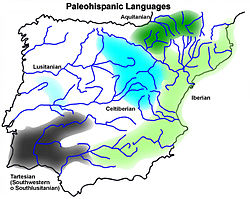An abjad, also abgad, is a writing system in which only consonants are represented, leaving the vowel sounds to be inferred by the reader. This contrasts with alphabets, which provide graphemes for both consonants and vowels. The term was introduced in 1990 by Peter T. Daniels. Other terms for the same concept include partial phonemic script, segmentally linear defective phonographic script, consonantary, consonant writing, and consonantal alphabet.
The Phoenician alphabet is an abjad used across the Mediterranean civilization of Phoenicia for most of the 1st millennium BC. It was one of the first alphabets, and attested in Canaanite and Aramaic inscriptions found across the Mediterranean region. In the history of writing systems, the Phoenician script also marked the first to have a fixed writing direction—while previous systems were multi-directional, Phoenician was written horizontally, from right to left. It developed directly from the Proto-Sinaitic script used during the Late Bronze Age, which was derived in turn from Egyptian hieroglyphs.

The Iberians were an ancient people settled in the eastern and southern coasts of the Iberian Peninsula, at least from the 6th century BCE. They are described in Greek and Roman sources. Roman sources also use the term Hispani to refer to the Iberians.
The Iberian language was the language of an indigenous western European people identified by Greek and Roman sources who lived in the eastern and southeastern regions of the Iberian Peninsula in the pre-Migration Era. An ancient Iberian culture can be identified as existing between the 7th and 1st centuries BC, at least.

The Cypriot or Cypriote syllabary is a syllabic script used in Iron Age Cyprus, from about the 11th to the 4th centuries BCE, when it was replaced by the Greek alphabet. It has been suggested that the script remained in use as late as the 1st century BC. A pioneer of that change was King Evagoras of Salamis. It is thought to be descended from the Cypro-Minoan syllabary, itself a variant or derivative of Linear A. Most texts using the script are in the Arcadocypriot dialect of Greek, but also one bilingual inscription was found in Amathus.

Celtiberian or Northeastern Hispano-Celtic is an extinct Indo-European language of the Celtic branch spoken by the Celtiberians in an area of the Iberian Peninsula between the headwaters of the Douro, Tagus, Júcar and Turia rivers and the Ebro river. This language is directly attested in nearly 200 inscriptions dated from the 2nd century BC to the 1st century AD, mainly in Celtiberian script, a direct adaptation of the northeastern Iberian script, but also in the Latin alphabet. The longest extant Celtiberian inscriptions are those on three Botorrita plaques, bronze plaques from Botorrita near Zaragoza, dating to the early 1st century BC, labeled Botorrita I, III and IV. Shorter and more fragmentary is the Novallas bronze tablet.

The Celtiberian script is a Paleohispanic script that was the main writing system of the Celtiberian language, an extinct Continental Celtic language, which was also occasionally written using the Latin alphabet. This script is a direct adaptation of the northeastern Iberian script, the most frequently used of the Iberian scripts.
The history of the alphabet goes back to the consonantal writing system used to write Semitic languages in the Levant during the 2nd millennium BCE. Nearly all alphabetic scripts used throughout the world today ultimately go back to this Semitic script. Its first origins can be traced back to a Proto-Sinaitic script developed in Ancient Egypt to represent the language of Semitic-speaking workers and slaves in Egypt. Unskilled in the complex hieroglyphic system used to write the Egyptian language, which required a large number of pictograms, they selected a small number of those commonly seen in their surroundings to describe the sounds, as opposed to the semantic values, of their own Canaanite language. This script was partly influenced by the older Egyptian hieratic, a cursive script related to Egyptian hieroglyphs. The Semitic alphabet became the ancestor of multiple writing systems across the Middle East, Europe, northern Africa, and South Asia, mainly through Phoenician and the closely related Paleo-Hebrew alphabet, and later Aramaic and the Nabatean—derived from the Aramaic alphabet and developed into the Arabic alphabet—five closely related members of the Semitic family of scripts that were in use during the early first millennium BCE.

Tartessian is an extinct Paleo-Hispanic language found in the Southwestern inscriptions of the Iberian Peninsula, mainly located in the south of Portugal, and the southwest of Spain. There are 95 such inscriptions; the longest has 82 readable signs. Around one third of them were found in Early Iron Age necropolises or other Iron Age burial sites associated with rich complex burials. It is usual to date them to the 7th century BC and to consider the southwestern script to be the most ancient Paleo-Hispanic script, with characters most closely resembling specific Phoenician letter forms found in inscriptions dated to c. 825 BC. Five of the inscriptions occur on stelae that have been interpreted as Late Bronze Age carved warrior gear from the Urnfield culture.

The Southwest Script, also known as Southwestern Script, Tartessian, South Lusitanian, and Conii script, is a Paleohispanic script used to write an unknown language typically identified as Tartessian. Southwest inscriptions have been found primarily in the southwestern quadrant of the Iberian Peninsula, mostly in the south of Portugal, but also in Spain.

The Paleohispanic scripts are the writing systems created in the Iberian Peninsula before the Latin alphabet became the dominant script. They derive from the Phoenician alphabet, with the exception of the Greco-Iberian alphabet, which is a direct adaptation of the Greek alphabet. Some researchers believe that the Greek alphabet may also have played a role in the origin of the other Paleohispanic scripts. Most of these scripts are notable for being semi-syllabic rather than purely alphabetic.

The northeastern Iberian script, also known as Levantine Iberian or simply Iberian, was the primary means of written expression for the Iberian language. It has also been used to write Proto-Basque, as evidenced by the Hand of Irulegi. The Iberian language is also represented by the southeastern Iberian script and the Greco-Iberian alphabet. In understanding the relationship between the northeastern and southeastern Iberian scripts, some note that they are two distinct scripts with different values assigned to the same signs. However, they share a common origin, and the most widely accepted hypothesis is that the northeastern Iberian script was derived from the southeastern Iberian script. Some researchers have concluded that it is linked solely to the Phoenician alphabet, while others believe that the Greek alphabet also played a role.

The southeastern Iberian script, also known as Meridional Iberian, was one of the means of written expression for the Iberian language, which was primarily written in the northeastern Iberian script and, to a lesser extent, by the Greco-Iberian alphabet. In understanding the relationship between the northeastern and southeastern Iberian scripts, some note that they are two distinct scripts with different values assigned to the same signs. However, they share a common origin, and the most widely accepted hypothesis is that the northeastern Iberian script was derived from the southeastern Iberian script.

The Greco-Iberian alphabet is a direct adaptation of an Ionic variant of a Greek alphabet to the specifics of the Iberian language, thus this script is an alphabet and lacks the distinctive characteristic of the paleohispanic scripts that present signs with syllabic value, for the occlusives and signs with monophonemic value for the rest of consonants and vowels.

The Espanca script is the first signary known of the Paleohispanic scripts. It is inscribed on a piece of slate, 48×28×2 cm. This alphabet consists of 27 letters written double. The 27 letters in the outer line are written in a better hand than those of the inner line, from which it has been inferred that the slate was a teaching exercise in which a master wrote the alphabet and a student copied it.

The paleo-Hispanic languages are the languages of the Pre-Roman peoples of the Iberian Peninsula, excluding languages of foreign colonies, such as Greek in Emporion and Phoenician in Qart Hadast. After the Roman conquest of Hispania the Paleohispanic languages, with the exception of Proto-Basque, were replaced by Latin, the ancestor of the modern Iberian Romance languages.

A semi-syllabary is a writing system that behaves partly as an alphabet and partly as a syllabary. The main group of semi-syllabic writing are the Paleohispanic scripts of ancient Spain, a group of semi-syllabaries that transform redundant plosive consonants of the Phoenician alphabet into syllabograms.

The Hand of Irulegi is a late Iron Age archaeological artifact unearthed in 2021 during excavations in the archaeological site of Irulegi (Navarre), next to the medieval castle of Irulegi, located in the municipality of Aranguren, Spain. The bronze artifact has the distinctive shape of a right hand with extended fingers. It has five separate strings of letters, probably corresponding to five or more words, carved on the side that represents the back of a hand.
Peñalba de Villastar is a Celtiberian sanctuary in the municipality of Villastar, Aragon, Spain. About 10km south of Teruel, it is located at the eastern edge of Celtic Iberia. The sanctuary is along a cliff 1500m in length, where soft white limestone and marl rock bears hundreds of inscriptions and graffiti.


















